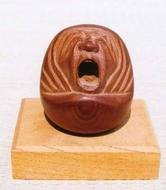. Index of Persons in the Darumapedia .
:::::::::::::::::::::::::::::::::::::::::::::::::::::::::::::::::::::::::::::::::::::::::::::::::::::
Daruma Pilgrims Gallery
:::::::::::::::::::::::::::::::::::::::::::::::::::::::::::::::::::::::::::::::::::::::::::::::::::::
Uesugi Kenshin Kagetora 上杉謙信(景虎)
(1530 - 1578)

- quote -
The Dragon of Echigo
(Nagao Kagetora)
As the head of the Nagao family, Kagetora turned to the difficult business of cementing his control over Echigo, a time-consuming process given that Echigo was noted for the fiercely-independent nature of it’s people.
... the capital and all the land around it was controlled by Oda Nobunaga, the rising ‘super-daimyô’ who had been the one to install Ashikaga Yoshiaki into the shogunate in 1568. Afterwards, Nobunaga had courted Kenshin’s favor with a series of gifts and letters that resulted in a pact against Takeda Shingen. Among the gifts Nobunaga sent to Kenshin were a pair of screens depicting life in Kyoto, known as the Rakuchû rakugai zu 洛中洛外図, which would later assist historians in gathering a sense of life in the capital at the time.
... Uesugi Kenshin was one of the most reknowned warlords of the 16th Century, a colorful figure who combined a love of campaigning with a thirst for learning and a genuine sense of honor. A devout religious man, Kenshin would never marry nor produce off-spring. Buddhist vows did not, however, prevent him from acquiring a taste for drink, which he consumed in copious amounts during his lifetime and may well have contributed to his early demise.
A man of learning, Kenshin enjoyed poetry and wrote the following piece in anticipation of his own death in 1578…
Even a life-long prosperity is but one cup of sake;
A life of forty-nine years is passed in a dream;
I know not what life is, nor death.
Year in year out-all but a dream.
Both Heaven and Hell are left behind;
I stand in the moonlit dawn,
Free from clouds of attachment.
Read his bigoraphy HERE !
© www.samurai-archives.com

Screens, present from Nobunaga
:::::::::::::::::::::::::::::::::::::::::::::::::::::::::::::::::::::::::::::::::::::::::::::::::::::
- quote -
Uesugi Kenshin Samurai House Codes
上杉謙信家訓 (kakun)
- - - - - 「宝在心」
・ 心に物なき時は、心廣く體泰(からだ やすらか)なり
・ 心に我儘(わがまま)なき時は、愛敬(あいきょう)失はず
・ 心に慾(よく)なき時は、義理を行ふ
・ 心に私(わたくし)なき時は、疑ふことなし
・ 心に驕(おご)りなき時は、人を敬(うやま)ふ
・ 心に誤(あやまり)なき時は、人を畏(おそ)れず
・ 心に邪見(じゃけん)なき時は、人を育つる
・ 心に貧なき時は、人に諂(へつら)ふことなし
・ 心に怒(いかり)なき時は、言葉和(おだや)かなり
・ 心に堪忍(かんにん)ある時は、事を調(ととの)ふ
・ 心に曇なき時は、心静(しずか)なり
・ 心に勇ある時は、悔(くや)むことなし
・ 心賤(いや)しからざる時は、願(ねがい)好まず
・ 心に孝行ある時は、忠節厚し
・ 心に自慢なき時は、人の善を知り
・ 心に迷(まよい)なき時は、人を咎(とが)めず
© shohoku_diary

:::::::::::::::::::::::::::::::::::::::::::::::::::::::::::::::::::::::::::::::::::::::::::::::::::::
Yonako Takizan Fudooji 米子瀧山不動寺
Yonako Takizan Fudo-Ji
長野県須坂市米子町1057 / Yonakomachi, Suzaka-shi, Nagano

The temple was founded by
. Gyōki Bosatsu 行基菩薩 Gyoki Bosatsu . - (668 - 749)
Gyoki built a small hall for a statue of 大日如来 Dainichi Nyorai, which he carved himself.

In 1559, Uesugi Kenshin received a statue of Fudo Myo-O from the regent in Kyoto to use it in unifying the Kanto region.

This statue, made from keyaki 欅 zelkova wood, had been made by 弘法大師(空海) Kobo Daishi Kukai on request of 嵯峨天皇 Saga Tenno, with the pious attitude:
ittoo sanrai 一刀三礼 carving one part and praying three times
In 1561, after the Battle of Kawanakajima, Kenshin placed this statue in the Oku no In of the Temple, named
米子瀧山威徳院不動寺

- - - - - Homepage of the temple
- reference source : yonakofudoson.net -

There are the Yonako Great Falls 米子大瀑布
不動瀧 Fudo Waterfall (85 m) and
権現瀧 Gongen Waterfall (75 m).
These two large waterfalls are among the 100 best of Japan.

Statue of Fudo Myo-O near the waterfall.
- Look at more amazing photos of the falls :
- source : nigejune.com/hiking-to-yonako-falls -
. Fudō Myō-ō, Fudoo Myoo-Oo 不動明王 Fudo Myo-O
Acala Vidyârâja – Vidyaraja – Fudo Myoo .
:::::::::::::::::::::::::::::::::::::::::::::::::::::::::::::::::::::::::::::::::::::::::::::::::::::
. Naoe Kanetsugu 直江兼続
Follower of the son of Kenshin.
:::::::::::::::::::::::::::::::::::::::::::::::::::::::::::::::::::::::::::::::::::::::::::::::::::::::::::::::::::::::::::
[ . BACK to DARUMA MUSEUM TOP . ]
[ . BACK to WORLDKIGO . TOP . ]
- #uesugikenshin #kenshinuesugi -
:::::::::::::::::::::::::::::::::::::::::::::::::::::::::::::::::::::::::::::::::::::::::::::::::::::::::::::::::::::::::::















































